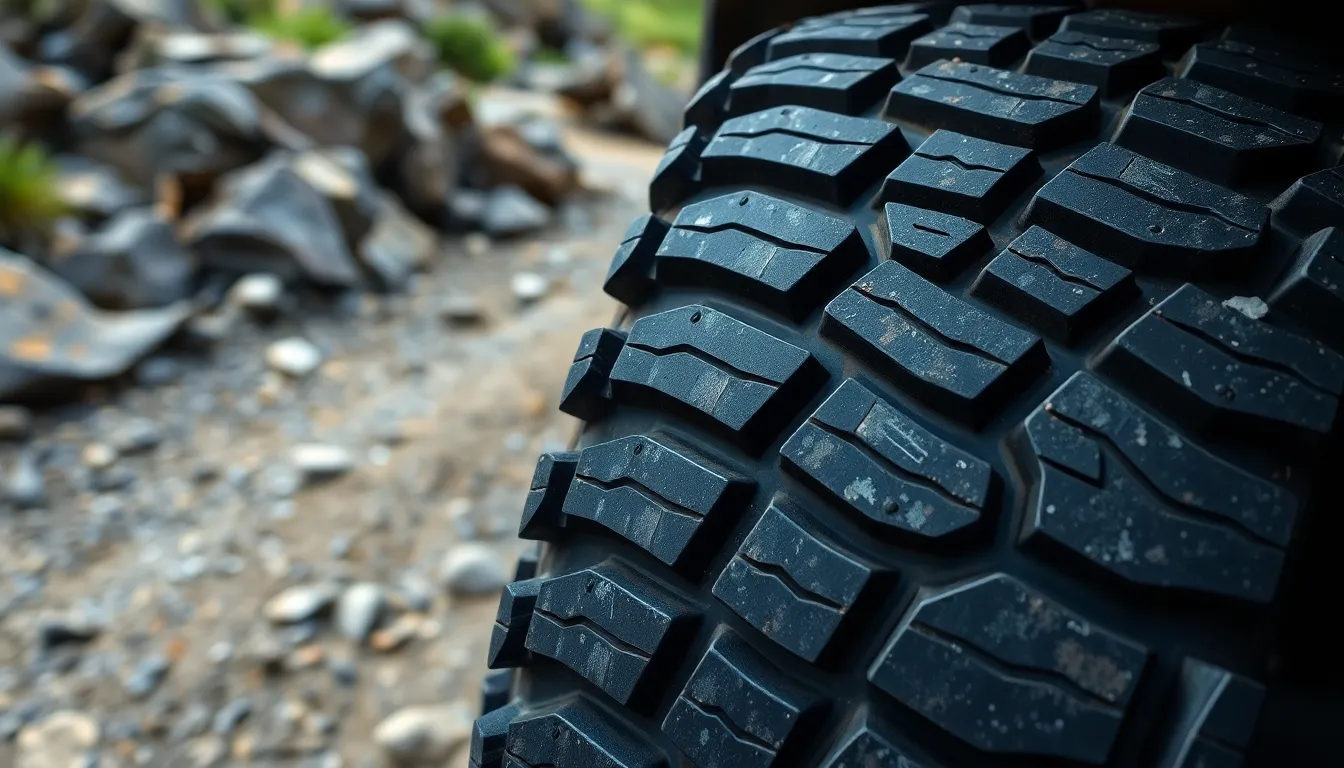We’ve all been there – standing in the tire shop wondering if those rugged all-terrain tires will turn our daily commute into a gas-guzzling nightmare. It’s a legitimate concern that keeps many drivers stuck between wanting better traction and keeping fuel costs manageable.
The truth about all-terrain tires and fuel economy isn’t as black and white as most people think. While these versatile tires do impact your gas mileage there’s more to the story than simple yes-or-no answers. Factors like tire design rolling resistance and your driving habits all play crucial roles in determining actual fuel consumption.
We’re diving deep into the real relationship between all-terrain tires and fuel efficiency. You’ll discover exactly how much gas mileage you might lose why it happens and whether the trade-offs are worth it for your exact needs. Let’s separate the myths from the facts and help you make an well-informed choice.
What Are All Terrain Tires?
All terrain tires represent a hybrid tire category engineered to deliver balanced performance across multiple driving surfaces. These versatile tires bridge the gap between highway tires and dedicated off road options.
Design and Construction Features
All terrain tires feature aggressive tread patterns with deeper grooves measuring 12-15/32 inches compared to highway tires’ 8-10/32 inches. The tread blocks incorporate larger spacing between lugs to enhance traction on loose surfaces like gravel dirt and sand. Sidewall construction utilizes reinforced rubber compounds with higher durometer ratings to resist punctures from rocks and debris.
Manufacturers engineer these tires with variable pitch tread designs to reduce road noise while maintaining off road capability. The rubber compounds blend harder materials for durability with softer elements for improved grip. Steel belt construction typically includes two steel belts with polyester cord body plies for enhanced strength and stability.
Shoulder blocks extend further down the sidewall compared to highway tires providing additional bite when airing down for off road traction. The void ratio in all terrain tires ranges from 15-25% creating channels for mud and debris evacuation while maintaining contact patch integrity on pavement.
Intended Use Cases
All terrain tires excel in mixed driving conditions where drivers encounter both paved roads and unpaved surfaces regularly. We recommend these tires for pickup trucks SUVs and crossovers that frequently transition between highway commuting and recreational activities like camping fishing or hunting.
Construction workers benefit from all terrain tires when accessing job sites on unpaved roads or loose surfaces. Rural property owners find these tires advantageous for handling gravel driveways dirt roads and seasonal terrain changes. Adventure enthusiasts choose all terrain tires for weekend excursions involving hiking trails forest service roads and moderate off road exploration.
Light snow and wet weather performance makes all terrain tires suitable for regions with mild winter conditions where dedicated winter tires aren’t necessary. Fleet vehicles operating in mixed environments use all terrain tires to maintain consistent performance across varied terrain without frequent tire changes.
Urban drivers living in areas with unpaved parking lots construction zones or seasonal road conditions find all terrain tires provide peace of mind for unexpected terrain encounters.
How Tire Type Affects Fuel Economy

Understanding the relationship between tire characteristics and fuel consumption helps us make informed decisions about all-terrain tire purchases. The design elements that make all-terrain tires effective off-road directly impact how much gas our vehicles consume.
Rolling Resistance Basics
Rolling resistance represents the energy required to keep tires moving forward on the road surface. All-terrain tires create approximately 3% higher fuel consumption compared to standard highway tires due to their deeper tread patterns and more substantial construction. Deeper treads and aggressive patterns increase the contact patch deformation, forcing engines to work harder to maintain consistent speeds.
Highway tires feature smoother tread designs that minimize energy loss during rotation. All-terrain models like the Nexen Roadian AT Pro RA8 and Continental TerrainContact A/T incorporate low rolling resistance technologies to reduce this impact. These tires use sipe-in-groove patterns and asymmetric tread designs that maintain off-road capability while preserving fuel efficiency.
Weight and Fuel Consumption
All-terrain tires typically weigh more than their highway counterparts due to reinforced construction and thicker rubber compounds. Extra weight requires additional energy to accelerate and maintain momentum, creating a compound effect on fuel economy beyond rolling resistance alone. Our vehicles must overcome both the increased mass and the higher resistance simultaneously.
| Factor | Impact on Fuel Economy |
|---|---|
| Rolling Resistance | 3% average increase in consumption |
| Additional Weight | Variable based on tire size |
| Combined Effect | Cumulative fuel efficiency reduction |
Manufacturers like Goodyear address this challenge through specialized rubber compounds in models such as the Wrangler AT/S, which reduces rolling resistance without compromising durability. Continental’s TerrainContact A/T uses special rubber formulations and asymmetric patterns to minimize the weight penalty while maintaining traction performance.
Do All Terrain Tires Waste More Gas?

All terrain tires do consume more fuel than highway tires, though the impact remains relatively modest for most drivers. Research consistently demonstrates that fuel economy decreases when switching from standard highway tires to all terrain alternatives.
Fuel Economy Comparison Studies
Studies reveal all terrain tires typically decrease fuel economy by approximately 3% compared to highway tires. This reduction stems from their heavier construction and aggressive tread patterns that create increased rolling resistance. Engineers measure this impact across various vehicle types and driving conditions to establish reliable benchmarks.
Weight differences between tire categories contribute significantly to fuel consumption variations. All terrain models weigh more than their highway counterparts due to reinforced sidewalls and deeper tread blocks. The additional mass requires engines to generate more power during acceleration and hill climbing scenarios.
Rolling resistance measurements show all terrain tires demand more energy to maintain constant speeds. Laboratory testing equipment quantifies the force required to keep tires rotating at exact velocities. These controlled environments eliminate variables like wind resistance and road grade to isolate tire performance characteristics.
Real-Industry Testing Results
Exact tire models demonstrate varying fuel efficiency levels within the all terrain category. The Pirelli Scorpion ATR, Continental TerrainContact A/T, and Goodyear Wrangler AT/S achieve better fuel economy through advanced tread designs and specialized rubber compounds. These manufacturers optimize their formulations to reduce energy loss while maintaining traction capabilities.
Tread depth measurements directly correlate with fuel consumption rates. Tires featuring shallower treads reduce rolling resistance compared to deeply grooved alternatives. This relationship creates a trade-off between aggressive off-road performance and on-road efficiency.
Fuel efficiency ratings provide standardized comparisons between tire models. The Nexen Roadian A/T Pro RA8 receives an 8/10 rating for fuel economy, outperforming more aggressive off-road oriented designs. These numerical assessments help consumers evaluate efficiency alongside other performance metrics.
Testing protocols examine real-industry driving scenarios including city traffic, highway cruising, and mixed terrain conditions. Data collection occurs across multiple vehicle platforms to account for weight distribution and aerodynamic differences. Results consistently show the 3% fuel economy reduction across diverse testing environments.
Factors That Impact All Terrain Tire Fuel Efficiency

Understanding the exact elements that influence fuel consumption helps us identify why all-terrain tires typically reduce gas mileage. Multiple variables work together to create the measurable efficiency differences we observe in real-industry testing.
Tread Pattern and Depth
Aggressive tread designs create the primary factor affecting fuel efficiency in all-terrain tires. Deeper tread blocks and wider grooves increase rolling resistance as they deform more during contact with road surfaces. Research demonstrates that heavier and more aggressive tire designs decrease fuel economy by 1 to 2 mpg compared to ultra-fuel-efficient highway tires.
Tread depth measurements directly correlate with fuel consumption rates across tire categories. All-terrain models feature deeper treads than highway counterparts to provide enhanced traction on loose surfaces. This design choice creates additional energy requirements as engines work harder to overcome increased rolling resistance.
Pattern complexity adds another dimension to fuel efficiency impacts. Interlocking tread blocks and aggressive shoulder designs generate more surface area contact with pavement. The resulting deformation patterns require more energy to maintain consistent speeds during highway travel.
Tire Pressure Considerations
Proper inflation maintains optimal fuel efficiency regardless of tire type or design. Underinflated tires significantly reduce fuel economy due to increased rolling resistance across the contact patch. Pressure monitoring becomes especially critical with all-terrain tires since their construction already creates higher baseline resistance.
Manufacturer specifications provide the foundation for maintaining efficiency in all-terrain applications. Following recommended pressure levels helps minimize the fuel consumption penalty associated with aggressive tread designs. Regular pressure checks ensure consistent performance as atmospheric conditions and driving patterns change.
Temperature fluctuations affect tire pressure and later impact fuel efficiency measurements. Cold weather reduces pressure levels while hot conditions increase them beyond optimal ranges. Maintaining proper inflation throughout seasonal changes preserves the best possible fuel economy with all-terrain tire selections.
Vehicle Type and Driving Conditions
Different vehicle categories experience varying degrees of fuel efficiency loss when equipped with all-terrain tires. Mid-size SUVs typically lose 5-8% in fuel efficiency while full-size trucks can experience 6-10% reductions compared to highway tire performance. Vehicle weight and aerodynamic characteristics influence these percentage differences.
Highway driving conditions reveal the greatest fuel efficiency penalties with off-road tire designs. Studies indicate that highway speeds account for 20-35% of total fuel efficiency loss when comparing all-terrain to highway tire performance. Urban stop-and-go traffic shows smaller percentage differences due to reduced rolling resistance impacts at lower speeds.
Terrain transitions create variable efficiency impacts throughout typical driving cycles. Mixed surface conditions where all-terrain tires excel may offset some highway efficiency losses through improved traction and reduced wheel spin. Rural routes combining paved and unpaved sections often demonstrate the smallest overall efficiency penalties.
Ways to Minimize Fuel Loss With All Terrain Tires

Drivers can carry out exact strategies to reduce the 3% fuel economy penalty typically associated with all terrain tires. Smart tire selection combined with proper maintenance creates measurable improvements in gas mileage performance.
Choose Low Rolling Resistance Models: Select all terrain tires specifically designed for fuel efficiency such as the Nexen Roadian AT Pro RA8, Continental TerrainContact A/T, Pirelli Scorpion ATR, or Goodyear Wrangler AT/S. These models feature advanced tread and rubber compounds that reduce energy loss while maintaining off-road capability.
Opt for Shallow Tread Patterns: Tires with shallower treads provide better fuel economy by reducing rolling resistance compared to deeply aggressive designs.
Proper Maintenance Practices
Regular tire rotation, balancing, and alignment ensures even wear patterns and optimal rolling resistance throughout the tire’s lifespan. Consistent maintenance practices help preserve the fuel efficiency characteristics that manufacturers engineer into low rolling resistance all terrain models.
Monitor tire pressure according to manufacturer specifications to maintain proper contact patch geometry. Underinflated all terrain tires create additional rolling resistance that compounds the existing 3% fuel economy reduction, while overinflated tires reduce traction effectiveness.
Schedule professional inspections every 6,000 miles to identify wear patterns that indicate alignment issues or suspension problems. Early detection prevents accelerated fuel consumption caused by improper tire contact angles.
Driving Habits That Help
Smooth acceleration patterns allow all terrain tires to maintain consistent rolling resistance without sudden energy spikes. Gradual speed changes optimize the tire’s contact patch dynamics and reduce the engine workload required to overcome rolling resistance.
Maintain steady highway speeds between 45-65 mph where all terrain tires operate most efficiently. Higher speeds exponentially increase aerodynamic drag, amplifying the fuel economy penalty beyond the baseline 3% reduction.
Reduce unnecessary idling periods that waste fuel without providing transportation benefits. Modern engines consume less fuel during restart cycles than extended idle periods, making frequent stops more efficient than prolonged waiting.
Avoid aggressive driving maneuvers that increase tire scrubbing and rolling resistance. Hard cornering and sudden braking create additional energy losses that compound the inherent fuel efficiency challenges of all terrain tire designs.
When All Terrain Tires Are Worth the Trade-Off

All terrain tires justify their 3% fuel economy reduction when their performance advantages align with exact driving requirements. The decision depends on evaluating actual benefits against measurable costs.
Performance Benefits vs. Fuel Costs
All terrain tires deliver superior traction and durability for off-road conditions, making them essential for vehicles that frequently venture beyond paved surfaces. These tires excel in mud, gravel, sand, and rocky terrain where highway tires fail completely. Enhanced sidewall construction prevents punctures and damage from sharp objects, reducing roadside emergencies and replacement costs.
The 3% fuel efficiency decrease translates to approximately $67.50 additional annual cost for drivers covering 15,000 miles. This modest expense becomes negligible when compared to the cost of being stranded with inadequate tires or the expense of switching between seasonal tire sets. Enhanced traction reduces accident risks in challenging conditions, potentially saving thousands in insurance claims and vehicle damage.
All terrain models provide extended tread life compared to highway alternatives in mixed driving conditions. Their robust construction withstands punishment from construction sites, rural properties, and outdoor recreation areas where standard tires deteriorate rapidly.
Cost-Benefit Analysis
Vehicles spending important time off-road generate substantial returns from all terrain tire investments. Construction workers, rural property owners, and outdoor enthusiasts experience immediate benefits that exceed the minor fuel cost increase. The enhanced safety margin alone justifies the expense for drivers regularly encountering unpaved surfaces.
Fuel efficient all terrain options like the Continental TerrainContact A/T and Michelin Defender LTX M/S minimize the efficiency penalty while maintaining off-road capability. These specialized designs use advanced rubber compounds and optimized tread patterns to reduce rolling resistance without sacrificing performance.
Urban drivers with occasional off-road needs can select shallow tread all terrain tires that offer better fuel economy. Weekend camping trips, boat launching, or emergency weather conditions provide sufficient justification for the minimal efficiency trade-off. The versatility eliminates the need for multiple tire sets, reducing storage requirements and seasonal changeover costs.
Fleet operators benefit from standardizing on fuel efficient all terrain tires across diverse vehicle applications. Single tire specifications simplify inventory management while ensuring capability for unexpected terrain challenges.
Conclusion
All-terrain tires do result in approximately 3% higher fuel consumption compared to highway tires but this modest trade-off often proves worthwhile for drivers who need enhanced traction and durability. We’ve found that the annual cost difference of around $67.50 for average drivers is relatively small compared to the safety and performance benefits these tires provide.
The key lies in making informed choices based on your exact driving needs. If you frequently encounter mixed terrain conditions or prioritize safety in challenging weather we believe all-terrain tires justify their slight fuel economy penalty.
For those seeking the best of both worlds modern fuel-efficient all-terrain options like the Continental TerrainContact A/T and Michelin Defender LTX M/S minimize efficiency losses while maintaining off-road capability. Combined with proper maintenance and mindful driving habits you can significantly reduce the fuel economy impact while enjoying enhanced versatility and peace of mind.
Frequently Asked Questions
Do all-terrain tires really hurt fuel economy?
Yes, all-terrain tires typically reduce fuel economy by approximately 3% compared to standard highway tires. This decrease is due to their deeper tread patterns, heavier construction, and increased rolling resistance. The aggressive tread design and reinforced sidewalls require more energy to maintain movement, forcing your engine to work harder and consume more fuel.
How much extra fuel will all-terrain tires cost me annually?
For drivers covering 15,000 miles annually, the 3% fuel economy reduction typically costs an additional $67.50 per year in fuel expenses. This modest increase is often justified by the enhanced traction, durability, and safety benefits that all-terrain tires provide, especially for vehicles that frequently encounter mixed driving conditions.
Which all-terrain tires offer the best fuel efficiency?
The Nexen Roadian AT Pro RA8, Continental TerrainContact A/T, and Michelin Defender LTX M/S are among the most fuel-efficient all-terrain options. These tires feature specialized rubber compounds and optimized tread designs that minimize rolling resistance while maintaining off-road capability, helping reduce the typical fuel economy penalty associated with all-terrain tires.
Can I improve fuel economy with all-terrain tires through maintenance?
Yes, proper maintenance significantly impacts fuel efficiency. Maintain manufacturer-recommended tire pressure, as underinflated tires worsen rolling resistance. Regular tire rotation, balancing, and wheel alignment help preserve optimal performance. Additionally, smooth driving habits like steady acceleration, maintaining 45-65 mph speeds, and avoiding aggressive maneuvers can help minimize fuel consumption penalties.
When do all-terrain tires justify their fuel economy trade-off?
All-terrain tires justify the 3% fuel penalty when you frequently drive on unpaved surfaces, need enhanced traction for safety, or want to avoid carrying multiple tire sets. They’re ideal for construction workers, rural property owners, outdoor enthusiasts, and urban drivers who occasionally encounter challenging terrain where the safety and performance benefits outweigh the modest fuel cost increase.
Do heavier all-terrain tires significantly impact fuel consumption?
Yes, the additional weight of all-terrain tires contributes to increased fuel consumption. Their reinforced sidewalls and deeper tread blocks make them heavier than highway tires, requiring more energy for acceleration and maintaining momentum. This weight difference, combined with increased rolling resistance, compounds the overall impact on fuel economy and vehicle performance.

